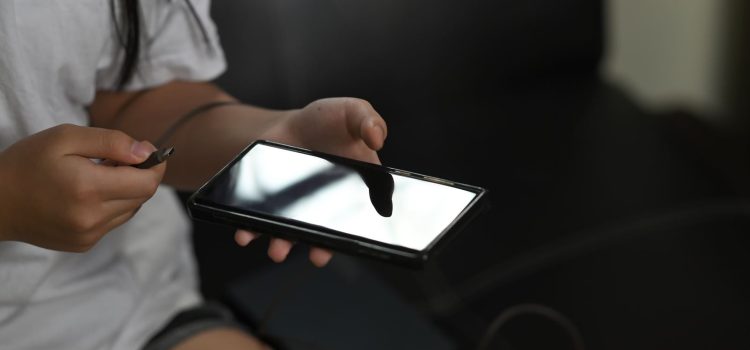
Do you reach for your smartphone dozens of times a day, even when you don’t need it? If so, you’re not alone. You’re caught in a cycle that affects millions of people worldwide—one where the very device designed to make life easier has become a source of distraction, anxiety, and disconnection. The solution isn’t about finding better apps or setting screen time limits; it requires a complete shift in focus away from constant digital stimulation and toward intentional, meaningful engagement with your real-world priorities.
In his book Unplug, Richard Simon argues that breaking free from smartphone dependency demands radical action: complete detachment for at least two months. Keep reading for an overview of the book.
Overview of Unplug
In Unplug (2025), journalist and digital strategist Richard Simon explains that this problem plagues countless people and reveals how to get past it. Based on a series of interviews and his own experiences, he argues that breaking up with your phone requires radical action—that is, complete detachment from your smartphone. Detachment feels uncomfortable at first but pays dividends by helping you build a more peaceful, fulfilling life.
In this guide, we’ll explore Simon’s ideas in two parts. First, we’ll discuss why you need to detach from your smartphone, explaining why you use your smartphone too much, the problems that result from doing so, and the benefits of breaking that habit. Then, we’ll discuss how to detach from your smartphone in four concrete steps. Throughout, we’ll add context about smartphone addiction from other experts and explore alternative routes toward healthier technology use.
Part 1: Why You Need to Detach From Your Smartphone
Practically everyone has a smartphone these days, and Simon says that like most people, you probably spend several hours a day using yours. In this section, we’ll explore how that happened—the reasons you (and everybody else) use your smartphone too much. Then, we’ll discuss the drawbacks of smartphone dependency and the benefits of detaching from your phone.
Why You Use Your Smartphone Too Much
Simon points to three major factors influencing people’s smartphone use: utility, addictiveness, and universality. Let’s explore each.
Factor #1: Utility
The first reason you’re drawn to use your smartphone often is that smartphones are undeniably useful. They’re sophisticated pieces of portable technology, equipped with tools that make navigating everyday life easier—maps for finding your way, calendars for organizing your schedule, cameras for capturing memories, and countless apps that put services and information at your fingertips. Because your smartphone centralizes so many essential functions in one device, it becomes the default tool you turn to throughout the day. It solves so many problems that frequently using it feels natural, or even unavoidable.
Factor #2: Addictiveness
Smartphones are useful, but utility alone doesn’t explain why you might reach for your phone dozens or even hundreds of times a day. The real reason for this, Simon says, is that smartphone makers design them to be addictive, according to experts like Adam Alter, author of Irresistible. Every time you use your phone, you’re surprised by what you find—you might receive new notifications or stumble on an interesting app or website, or you might not. It’s easy to find out which will happen; all you have to do is tap or swipe. This combination of unpredictability and frictionlessness keeps you coming back to your phone—and each time you do, your brain releases a burst of dopamine, training you to repeat the behavior.
Over time, the behavior becomes habitual: You use your phone unconsciously, without even realizing you’ve done so. For example, you might pull out your phone every time you’re in a waiting room or elevator, not because you need it, but simply out of habit.
Factor #3: Universality
The final factor influencing you to use your phone more than you should is its universality: Most people have smartphones, and the world is increasingly organized around them. From banking and shopping to socializing and working, many aspects of daily life now assume constant phone access. Without your phone, you risk missing out on important updates, being left out of conversations with friends, or losing convenient access to essential services and opportunities. Simon explains that these pressures make it even harder to put your smartphone down.
The Drawbacks of Dependency and the Benefits of Detaching
The factors we’ve just discussed can make your phone feel more like an appendage than a tool. But why is that a problem? As part of his research, Simon interviewed several people about the problems they experienced when overusing their smartphones and the benefits they reaped when they detached from their phones. Let’s explore those drawbacks and benefits now.
Inattention Versus Focus
Most of the people Simon interviewed felt distracted by their smartphones. Simon suggests that your phone can distract you in two ways: First, the barrage of notifications you receive constantly interrupts your train of thought and your experience of the present moment. Second, your impulse to frequently check your phone fragments your attention, making it difficult to stay immersed in any one task. This state of inattention leads to the other drawbacks of smartphone overuse we’ll discuss—an inability to connect with others, feel your feelings, be productive, or relax.
Although Simon’s interviewees lived distractedly when they were too attached to their phones, detaching allowed them to restore their ability to focus. As a result, most of them went on to achieve more and better things in their personal and professional lives. For example, Simon describes how chess grandmaster Wesley So dramatically improved his game after he cut back on screen time and, eventually, stopped using his phone entirely. Taking these steps enabled So to channel more energy into deep practice, which requires long periods of concentration. In turn, he could compete at higher and higher levels, and gradually he became one of the highest-ranking chess players in the world.
Isolation Versus Connection
Simon argues that your smartphone-induced inability to focus also isolates you from your friends, family, romantic partner, and community. This happens in two ways. First and most obviously, when you’re using your phone, you’re not engaging with those around you. This means that when you’re on a date with your partner or at the park with your kids, you and your loved ones miss out on important moments of connection that would otherwise strengthen your relationships. Being on your phone all the time also stops you from interacting with the strangers you encounter when you’re out and about, which deprives you of meaningful social exchanges and a sense of belonging.
The second way your smartphone isolates you is by replacing rich, face-to-face interaction with superficial, technology-mediated exchanges. Simon notes that, like many people, you might maintain some connections exclusively (or almost exclusively) over text or social media. But even if you message back and forth all day, these conversations rarely offer the depth of a phone call or an in-person conversation. Further, over text, it’s easy to fire off a quick, impulsive reply—something you’d be less likely to say in person or even over the phone—that leads to unnecessary conflict. Over time, this reliance on shallow, text-based exchanges can leave relationships feeling more fragile than they would if nurtured more directly.
In contrast, says Simon, your relationships tend to bloom when you detach from your smartphone. You might find that some friendships can’t withstand the challenge—when it becomes less convenient to connect via text, these friends fade away. But in other cases, your loved ones will go the extra mile to get in touch with you (and vice versa); you’ll intentionally schedule opportunities to spend time together or talk over the phone. Your conversations will grow deeper, and as a result, your relationships will grow stronger. This can have a positive ripple effect if you have children: They’ll watch your healthy relationships flourish and learn about connection, communication, and emotional intimacy as you model these.
Numbness Versus Engagement
Simon observes that by offering you constant stimuli, your smartphone can act like a numbing agent that lets you avoid rather than confront uncomfortable feelings. It provides a quick escape from emotions like anxiety, sadness, and boredom—for example, you might entertain yourself with your phone every time you use the bathroom or wait in line (activities that are boring because they aren’t mentally stimulating).
This gives your brain a temporary sense of relief, but that comes at a cost: Avoiding difficult feelings prevents you from processing them, reflecting on your experiences, and gaining insight into yourself. It also makes daydreaming, problem-solving, planning for the future, and creative thinking less likely. Because every spare moment is filled with digital distraction, you lose the quiet mental space where new ideas emerge and deeper understanding develops.
In contrast, when you detach from your phone, you give yourself more opportunities to engage with your thoughts and feelings. At first, this can feel uncomfortable and vulnerable. Yet Simon argues this is exactly what strengthens you: Processing your emotions directly allows you to understand them, resolve them, and even share them with others. Giving yourself time to feel your feelings rather than retreating into your phone may also lead you to reach out for support when you’re struggling, which fosters intimacy and trust in your relationships.
Purposelessness Versus Productivity
Simon says that by making you more distractible, your smartphone also stops you from making progress toward greater work-related and personal pursuits. Because your phone—and your impulse to check it—constantly interrupt you, you never achieve what author Cal Newport calls “deep work” in his book of the same name. Newport defines deep work as focused work on a task that pushes your cognitive abilities to their limit—a stretch that allows you to hone your skills and make progress toward your goals.
When your phone prevents you from working deeply, Simon explains, it keeps you stuck in a state of purposelessness; you’re too distracted by trivial notifications and tasks (like answering nonurgent texts) to build momentum toward meaningful achievements. Newport focuses on how this affects your career, but Simon says it also gets in the way of your hobbies. Say your hobby is whittling—to shape a block of wood into something recognizable, you need time and steady concentration. But if you interrupt yourself every few minutes to check your phone, you lose the meditative rhythm that makes whittling fruitful and fun. Instead of watching the form gradually emerge in your hands, you find yourself disappointedly staring at half-finished scraps.
Simon’s interviewees reported that detaching from their smartphones helped them move from a state of purposelessness into an era of greater productivity. They advanced in their careers, and they took up and mastered new hobbies that brought them a greater sense of fulfillment. Simon adds that most of his interviewees’ new hobbies were hands-on, nature-based activities, like beekeeping, that engaged their senses in ways smartphones never could. These activities allowed them to feel textures, notice colors, hear natural sounds, and smell the outdoors—all experiences that created a heightened sense of presence and satisfaction.
Overwhelm Versus Calm
The final drawback of smartphone overuse that Simon explores is the sense of overwhelm you feel because you’re constantly connected to other people. This constant connectivity is one of the smartphone’s main selling points—you can get in touch with anybody at any time, which we appreciate in case of emergencies or urgent work communications. But Simon argues that we overvalue constant connectivity—emergencies are rare, and for most people, work-related issues rarely require a truly immediate response. Still, you feel pressure to always be available and to respond instantly when someone contacts you. This leaves you feeling mentally exhausted, anxious, and perpetually behind.
Detaching from your smartphone helps you restore your sense of calm by making life feel less demanding. If someone truly needs to get in touch with you, they’ll find another way—for example, by showing up to your house to inform you of a family emergency. In the meantime, you enjoy a more peaceful day-to-day existence without constant intrusions from the outside world. You can also pace your information intake in a way that empowers you rather than stressing you out. Simon explains that he detached from his phone during the Covid-19 pandemic, choosing to read a daily newspaper instead of constantly checking real-time updates online. This helped him stay aware of important developments without becoming overwhelmed.
Part 2: How to Detach From Your Smartphone
Now that you know why you should detach from your smartphone, let’s talk about how to do so effectively: According to Simon, you have to stop using it entirely for at least two months. This may seem radical, but psychiatrist and addiction expert Anna Lembke says it’s necessary. In Dopamine Nation, Lembke explains that abstinence helps reset your brain’s dopamine system (the same system that, according to Simon, compels you to use your phone too much). If you try to modify your behavior without this total reset—for example, by setting limits on how long you use your phone each day—you’ll fail. This is because if you keep feeding your brain the dopamine that comes from looking at your phone, it’ll never get over its craving for more dopamine.
Simon explains that going two months without your smartphone isn’t easy—you might suffer some psychological discomfort and even physical withdrawal symptoms as you adjust. But you can overcome these challenges and successfully detach from your phone by following four straightforward steps; let’s explore those now.
Step 1: Get Ready to Detach
Before you stop using your smartphone, consider how doing so will affect your life and the lives of people around you. Specifically, Simon recommends clarifying what you hope to get out of the experience and planning for any practical challenges you might face.
Clarify Your Goals
Your goals are the things you hope to achieve by detaching from your smartphone. Simon recommends thinking about these in terms of activities you’d like to spend more of your time on. Write out a list of activities that covers as many aspects of your life as possible—for example, you might have artistic goals like finishing a long-abandoned painting and fitness goals like trying a new sport, learning goals like mastering a new coding language, and social goals like reconnecting with a friend you haven’t seen in months. This ensures that you have plenty of options to choose from when you feel tempted to go back to your phone.
Simon also urges you to focus on screen-free activities rather than screen-dependent activities as you create your list of goals. Because the point of detaching from your smartphone is to reset your dopamine system, you need to prioritize activities that provide natural, sustained rewards rather than quick, digital hits of dopamine.
Plan for Practical Challenges
Once you have an idea of what you want to achieve by detaching from your phone, start strategizing how to manage practical challenges. Simon explains that planning ahead reduces anxiety and prevents surprises that might lead you to use your phone again. For example, say you usually use an app to check public transit schedules. If you find a replacement method ahead of time—like a printed schedule or a website you can access from your computer—you can avoid the urge to reach for your phone the next time you plan a daytrip.
Communication is the most important practical challenge to address. Simon says that since you’re the one making a change and doing something out of the ordinary, the onus is on you to proactively communicate your plan to friends, family, and colleagues. Let them know when you plan to stop using your phone, how long your break will last, how they can schedule a meet-up or phone call, and the best ways to reach you for urgent matters and emergencies. Clear communication reduces misunderstandings, prevents frustration, and ensures that detaching from your smartphone doesn’t unintentionally disrupt your relationships or responsibilities.
If your friends, family, or coworkers are reluctant to accept the changes you’re proposing, Simon recommends sharing the goals you clarified earlier—explaining your motivations for detaching can help you win others’ buy-in and support. Having their support is important because when they understand your goals, they’re more likely to respect your boundaries, offer encouragement, and avoid unintentionally pulling you back into constant phone use.
Step 2: Detach From Your Smartphone
Simon explains that once you’ve planned adequately, you can start your two-month break from your smartphone. He recommends doing this in one of two ways:
First, you can simply power off your smartphone for the duration of your break. This means you’ll be completely reliant on alternative tools for communication, information gathering, and whatever else you used your smartphone for in the past. For example, you might install a landline phone and buy a pedometer to count your daily steps. The benefit of this approach is that your smartphone is still there if you need it to do something urgent, like call an ambulance during a medical emergency. But Simon warns against using your smartphone for conveniences, like ordering takeout because you forgot to thaw tonight’s dinner. Doing so undermines the purpose of your break.
Your second option is to switch to a “dumbphone,” a minimalistic mobile phone that allows you to call, text, and perform other basic tasks like setting alarms. Dumbphones lack the features that make smartphones so addictive, like apps, and they’re not as intuitive or pleasant to use as a smartphone. Their screens are smaller and simpler, their physical keypads are harder to use than digital keyboards, and their hardware doesn’t support complex apps or constant communication. So, they’re far less likely to hijack your attention. The friction keeps you from reaching for your phone out of habit and helps you reserve it for true communication needs. As a result, you’ll naturally be less attached to it than you are to your smartphone.
Whichever route you choose, Simon suggests that it’s helpful to find a quit buddy—someone who will give up their smartphone at the same time as you. Having a partner in the process makes the challenge feel less isolating and more motivating. Because you’ll each understand what the other is going through, you can vent and strategize about challenges and celebrate successes together. You can also spend time together in person—time you’d have spent separately on your phones before—which will help satisfy your need for connection in ways your smartphone never could. These benefits make it more likely that both of you will stay committed to detaching from your devices.
Step 3: Find Your New Normal
Simon writes that after spending two months without their smartphones, most people never go back. Instead they tend to stick with whichever option they chose in Step 2, prolonging their detachment from their smartphones indefinitely. But others find reintroducing smartphones to their lives a necessity. Let’s explore Simon’s tips for navigating each of these options.
Option 1: Never Use Your Smartphone Again
Simon says there’s a good reason never to use your smartphone again after detaching from it: You might become addicted to it all over again. When people struggling with substance addiction re-encounter the substances they’re addicted to after a period of sobriety, it can catalyze physical processes that reignite cravings and quickly undo years of progress. Researchers haven’t studied whether this is true of smartphone addiction, but Simon recommends exercising caution anyway. He also notes that one of his interviewees completely regressed into smartphone addiction after detaching for over five years, suggesting that the device’s allure is so strong that even long-term abstinence may not guarantee lasting freedom.
Deciding never to use your smartphone again is a safe way to avoid becoming re-addicted to it. But without your smartphone, you lose access to several tools that make everyday life easier and more enjoyable. To cope with this, Simon recommends investing in alternative devices that don’t have the same addictive pull.
For example, if you miss using your smartphone to listen to music, he recommends buying an MP3 player or another dedicated music device. These might feel more cumbersome to use, but this can make your listening experience more enjoyable. You won’t constantly have music that you’re barely paying attention to playing in the background as you go about your day anymore. Instead, your listening experience will transform from one that’s passive and absent-minded into one that’s active and intentional. You’ll set time aside to choose the music you want to listen to and savor it as it plays, without other distractions competing for your attention.
Option 2: Use Your Smartphone Less Often
Simon observes that never using your smartphone again doesn’t work for everyone. Special circumstances might make re-adopting your smartphone necessary—for example, if you have a disability like blindness, you might rely on accessibility apps like Be My Eyes to help you navigate the world safely. If you find that you need a smartphone after your initial detachment period ends, use strategies that allow you to get what you need from it without slipping back into compulsive use. Here are a few strategies that worked for Simon’s interviewees:
- One person kept their phone on silent, setting time aside once each day to respond to messages. That way, they weren’t constantly distracted by notifications.
- Another person created multiple focused home screens so they could focus on one task at a time without being distracted by other apps. For example, all their shopping apps were on one home screen; all their social media and messaging apps were on another.
- A third person was issued a smartphone for work and left it at their workplace when they weren’t using it. This allowed them to maintain clear boundaries between their work and their personal life.
Step 4: Help Others Detach
The final step Simon recommends is helping others detach from their smartphones by sharing your journey and encouraging them to experiment with their own screen-free practices. This step is important because it helps normalize more mindful phone use. Think about how using your phone too much has made you feel in the past—that’s exactly what the average person struggles with every day. By opening up about how detaching has changed your life, you make the idea of detaching less intimidating and more relatable, showing people that change is possible and worthwhile. You might also make new friends this way; since minimizing your smartphone use is unusual, people will notice that you do this and want to talk about it.
To illustrate how this step can bring people together, Simon discusses how musician Jack White approaches it. White doesn’t use a mobile phone at all and doesn’t allow phone use at his concerts. To enforce this rule, he contracts with a company that provides secure pouches for attendees to lock their devices in before entering the venue. If fans need to use their phones, they can step outside to unlock the pouch. By removing smartphones from the experience, Simon explains, White creates an atmosphere where people are fully immersed in the music and more present with one another—an experience fans enjoy.
Exercise: Evaluate Your Smartphone Use
Simon explains that while smartphones are useful, they can decrease your quality of life. In this exercise, you’ll evaluate the impact your smartphone use has on you.
- How long do you think you use your smartphone each day? How do you feel about that number?
- Which kinds of apps do you use most often? For example, maybe you use social media apps, messaging apps, health tracking apps, and navigation apps almost every day.
- What goals do these tools help you accomplish? For example, your health tracking apps might help you count calories, so you can get closer to your weight loss goal.
- Do any of the apps you use feel like time-wasters that prevent you from achieving your goals? If so, what would you rather be doing with the time you waste using them?
- Would you describe your smartphone use as helpful or problematic, overall? If it’s problematic, which of Simon’s strategies could you use to move toward healthier smartphone use? For example, you might consider switching to a dumbphone for two months (or indefinitely).






